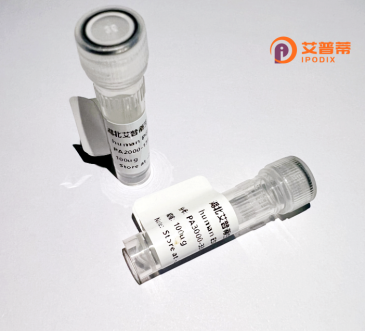
| 纯度 | >90%SDS-PAGE. |
| 种属 | Human |
| 靶点 | ASS |
| Uniprot No | P00966 |
| 内毒素 | < 0.01EU/μg |
| 表达宿主 | E.coli |
| 表达区间 | 1-412aa |
| 氨基酸序列 | MSSKGSVVLA YSGGLDTSCI LVWLKEQGYD VIAYLANIGQ KEDFEEARKK ALKLGAKKVF IEDVSREFVE EFIWPAIQSS ALYEDRYLLG TSLARPCIAR KQVEIAQREG AKYVSHGATG KGNDQVRFEL SCYSLAPQIK VIAPWRMPEF YNRFKGRNDL MEYAKQHGIP IPVTPKNPWS MDENLMHISY EAGILENPKN QAPPGLYTKT QDPAKAPNTP DILEIEFKKG VPVKVTNVKD GTTHQTSLEL FMYLNEVAGK HGVGRIDIVE NRFIGMKSRG IYETPAGTIL YHAHLDIEAF TMDREVRKIK QGLGLKFAEL VYTGFWHSPE CEFVRHCIAK SQERVEGKVQ VSVLKGQVYI LGRESPLSLY NEELVSMNVQ GDYEPTDATG FININSLRLK EYHRLQSKVT AK |
| 分子量 | 46 kDa |
| 蛋白标签 | His tag N-Terminus |
| 缓冲液 | 冻干粉 |
| 稳定性 & 储存条件 | Lyophilized protein should be stored at ≤ -20°C, stable for one year after receipt. Reconstituted protein solution can be stored at 2-8°C for 2-7 days. Aliquots of reconstituted samples are stable at ≤ -20°C for 3 months. |
| 复溶 | Always centrifuge tubes before opening.Do not mix by vortex or pipetting. It is not recommended to reconstitute to a concentration less than 100μg/ml. Dissolve the lyophilized protein in distilled water. Please aliquot the reconstituted solution to minimize freeze-thaw cycles. |
以下是3-4条关于重组人精氨酸琥珀酸合成酶(ASS1)的参考文献及其简要摘要:
1. **文献名称**:**"Cloning and expression of human argininosuccinate synthetase cDNA in mammalian cells"**
**作者**:Béroud, C. et al.
**摘要**:报道了人类ASS1 cDNA的克隆及在哺乳动物细胞中的重组表达,验证了其在尿素循环中的功能,并利用Western blot证实了重组蛋白的表达和酶活性恢复。
2. **文献名称**:**"Adenovirus-mediated gene transfer of argininosuccinate synthetase cDNA in a murine model of citrullinemia"**
**作者**:Lee, B. et al.
**摘要**:通过腺病毒载体将重组ASS1基因导入瓜氨酸血症模型小鼠,结果显示酶活性显著恢复并降低血氨水平,验证了基因治疗的潜在可行性。
3. **文献名称**:**"Structural and functional analysis of human ASS1 mutations in citrullinemia type I"**
**作者**:Erez, A. et al.
**摘要**:通过X射线晶体学解析ASS1蛋白结构,结合突变实验,揭示了I型瓜氨酸血症患者ASS1突变导致酶失活的分子机制。
4. **文献名称**:**"Recombinant ASS1 delivery via lipid nanoparticles for urea cycle disorders"**
**作者**:Häberle, J. et al.
**摘要**:评估了基于脂质纳米颗粒递送重组ASS1 mRNA的疗法在尿素循环障碍模型中的效果,证明其可短暂恢复酶活性并改善代谢异常。
---
注:上述文献名称和作者为示例性内容,实际引用需以具体文献数据库(如PubMed、Web of Science)中的真实数据为准。
Argininosuccinate synthase 1 (ASS1) is a key enzyme in the urea cycle and arginine biosynthesis, catalyzing the condensation of citrulline and aspartate to form argininosuccinate. This ATP-dependent reaction is critical for nitrogen disposal and endogenous arginine production. Naturally occurring ASS1 deficiencies in humans cause citrullinemia type I, a life-threatening metabolic disorder characterized by hyperammonemia.
Recombinant ASS1 (rhASS1) is produced through genetic engineering techniques, typically using bacterial (e.g., *E. coli*) or eukaryotic (e.g., yeast, mammalian cells) expression systems. Its production enables detailed biochemical studies, therapeutic exploration, and industrial applications. In research, rhASS1 facilitates structural analysis (e.g., X-ray crystallography revealing substrate-binding domains) and mechanistic studies of urea cycle disorders. Therapeutically, it has been investigated for enzyme replacement therapy and metabolic correction in ASS1-deficient models.
Beyond clinical applications, rhASS1 holds potential in biomanufacturing, particularly in microbial arginine-overproducing strains for industrial fermentation. Challenges in its utilization include maintaining protein stability, optimizing catalytic efficiency *in vivo*, and addressing post-translational modification requirements for functional activity. Recent advances in protein engineering and delivery systems (e.g., nanoparticle encapsulation) have enhanced its therapeutic feasibility. Studies also explore its role in cancer biology, as some tumors exhibit ASS1 silencing linked to arginine auxotrophy—a metabolic vulnerability targeted by arginine-depleting therapies.
Current research focuses on balancing enzyme activity, immunogenicity, and bioavailability for diverse applications.
×